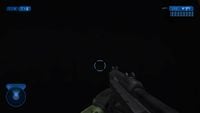Heads-up display: Difference between revisions
From Halopedia, the Halo wiki
(→Trivia) |
Spartan G-23 (talk | contribs) m (→Images) |
||
| Line 40: | Line 40: | ||
Image:MjolnirMKVIHUD.jpg|The MJOLNIR HUD from [[Halo 2]]. | Image:MjolnirMKVIHUD.jpg|The MJOLNIR HUD from [[Halo 2]]. | ||
Image:H3_E307_FP01.jpg|The new Spartan HUD in Halo 3. | Image:H3_E307_FP01.jpg|The new Spartan HUD in Halo 3. | ||
Image:EliteHUDH3.jpg|The new Elite HUD in Halo 3. | Image:EliteHUDH3.jpg|The new Elite HUD in [[Halo 3]]. | ||
Image:Gruntblack.jpg|The HUD from Halo:CE | Image:Gruntblack.jpg|The HUD from Halo:CE | ||
</gallery> | </gallery> | ||
Revision as of 18:38, February 4, 2008
Summary
The Heads Up Display unit, or more clearly known through it's military acronym HUD, is a visor mounted display, and is one of the most useful elements present in the MJOLNIR Armor, coming just short of their Personal Energy Shields.
The Heads-Up Display is the main source for information in-game on Halo: Combat Evolved, Halo 2 and Halo 3, though the appearance of the HUD has changed dramatically from its predecessors[1][2][3]. The sensors augmented into the Spartan's body display the soldier's vital signs, which include a measure of their overall health in the form of bars. Note that this "health bar" has been removed from Halo 2 and Halo 3, with the reason being to the insertion of automatic bio-foam injectors into the Mark VI armor.[4]. In Halo 3, there a slight convex appearance to simulate looking through a real visor. Also, the MJOLNIR shields flare up in a grid-shaped pattern, to simulate the player is taking damage. Additionally, the HUD also reports the strength of the wearer's shields through the energy signatures it emanates. Weapons heat and ammunition levels, as well as grenade type and count are also detected through sensors placed in the Spartan's gloves. In Halo 2, the Mark VI armor is able to register two weapons when the Spartan is duel-wielding.
The Motion Sensor is another important feature displayed on the HUD. It can sense and track movement in a 15 meter radius (Halo 1), a 20 meter radius (Halo 2) and a 25 meter radius (Halo 3). Due to the insertion of IFF tags in UNSC soldiers, the radar can distinguish friend (yellow) from foe (red). Finally, the way point indicators are an on-screen directive that point out important objectives or locations in the Spartan's mission, and are extremely useful, measuring the distance the Spartan is from the objective.
A HUD display is also featured on SPI Armor, MJOLNIR armor, ODST Body Suits, Marine Body Armor, and even the Elite armor.
Confirmed Readouts
MJOLNIR armor, SPI armor, and Elite armor
The standard MJOLNIR armor contains the following readouts:
- A meter displaying the relative Vitality of the user (absent from Halo 2 and Halo 3).
- A gauge displaying Shield integrity status.
- A gauge tracking the quantity of ammunition available for weapons carried.
- A motion tracker.
- A counter tracking the number and type of Grenades carried.
- A targeting reticule which changes relative to the weapon currently in use.
- Acknowledgment lights from other members of the wearer's team.
- Maps and information uploaded over the wearer's TACCOM.
- Zoom Function or function for using a Fiber Optic Probe (absent from Halo: Combat Evolved).
ODST Body Suit and Marine Body Armor
The standard ODST and Marine armor contains the following readouts:
- A gauge tracking the quantity of ammunition available for weapons carried
- A motion tracker
- A counter tracking the number and type of Grenades carried
- A targeting reticule
- Acknowledgment lights from other members of the wearer's team
- Maps and information uploaded over the wearer's TACCOM.
Images
- Oldhalo.jpg
The HUD in a Pre-Xbox version of Halo.
HUD for MJOLNIR Mk. V, from Halo:Combat Evolved.
The MJOLNIR HUD from Halo 2.
- H3 E307 FP01.jpg
The new Spartan HUD in Halo 3.
The new Elite HUD in Halo 3.
- Gruntblack.jpg
The HUD from Halo:CE
Trivia
- It is unknown how the Combat Harness-bearing Elites see their HUD due to the fact that they have no visor or digital readout. A possibility is that they are able to view the information thanks to cybernetic optical implants.
- Custom games in Halo 3 let you be able to change how far your radar reads (10 metres, 25 metres, 75 metres or 150 metres).


